Scientific names (common names)
- Salvia species (salvia, sage)
- Salvia greggii ‘Furman’s Red’ (Furman’s red autumn sage)
- Salvia darcyi ‘Pscarl’ VERMILION BLUFFS (Vermilion Bluffs Mexican sage)
Plant family: Lamiaceae – mint
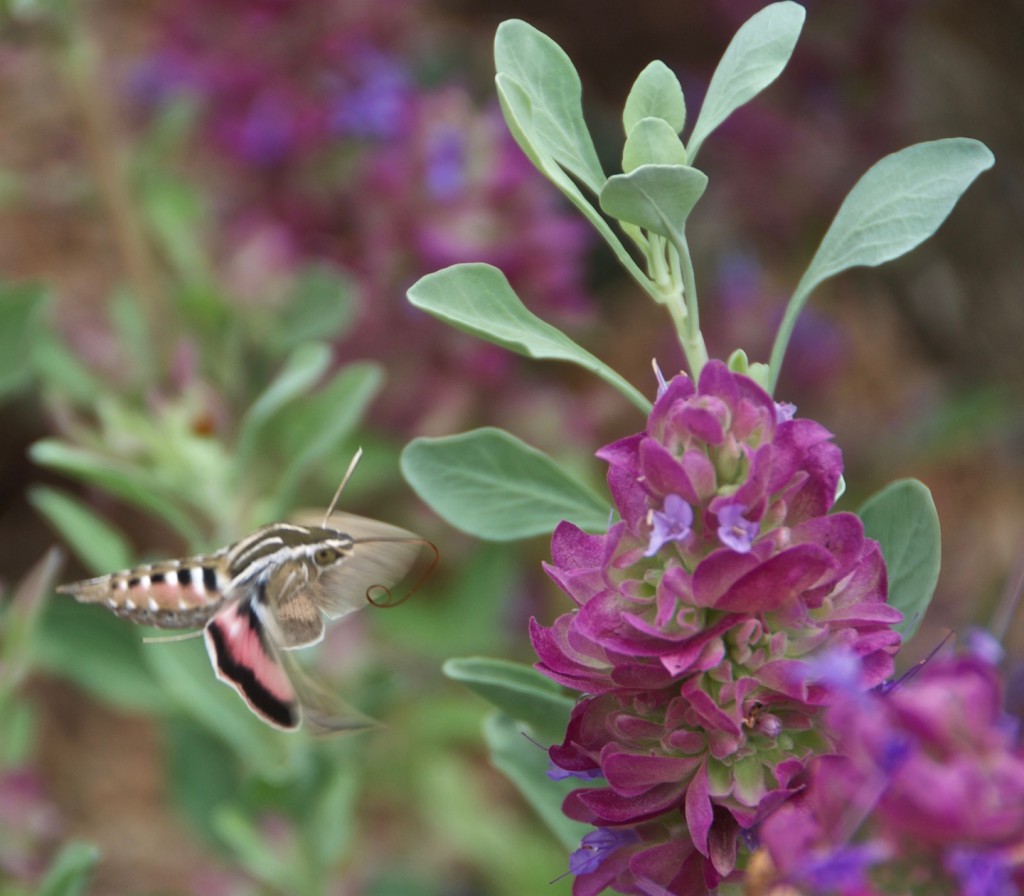
Sphinx moth on Mojave sage (Photo by Janice Tucker)
Article and photos by Janice Tucker
We celebrate the joy of gardening by surrounding ourselves with plants that render riotous colors, a mixture of textures and delicious scents. Gardeners who have lived in Santa Fe for a while usually know which plants satisfy such needs. But if you are a newcomer to our dry climate you may ask, “Are there readily available perennial plants with fragrant, colorful flowers that bloom from spring to autumn?”
Say hello to Salvia.
Those strolling through the Botanical Garden at Museum Hill may start salivating for Salvia in eye-popping colors of electric blues, rich purples, hot pinks, snowy whites and fiery reds. And even a brief whiff of their scent might cause one to experience an unexpected desire for grandma’s mouth-watering, sage-flavored, cornbread stuffing. These sun-loving plants fill the senses with a variety of vibrant colors whose leaves and flowers release a tantalizing fragrance. Salvia plants are noisy hubs of activity as bees buzz around their sweet-smelling flower spikes. Butterflies, moths and hummingbirds may tend to be a bit quieter than the bees but they also frequent the Salvia’s dining table.
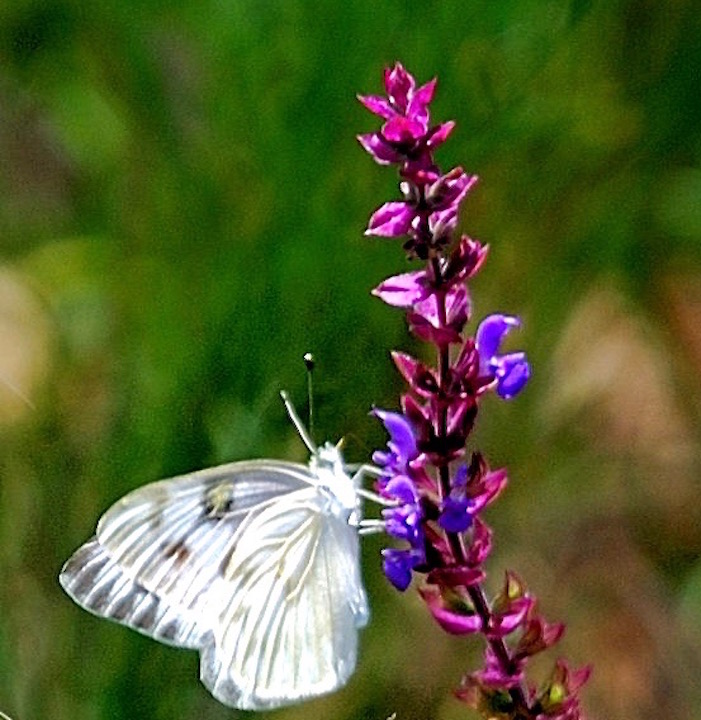
Checkered white butterfly on blue salvia (Photo by Janice Tucker).
The growth habit of Salvia is roughly divided into herbaceous plants or small, woody subshrubs that occur annually, biennially or perennially. With over 1000 species, hybrids and numerous cultivars, Salvia is the largest genus in the Lamiaceae (mint) family. Salvia is native to the Americas, Asia and the Mediterranean region. Due to cultivation they have spread to many other parts of the world.
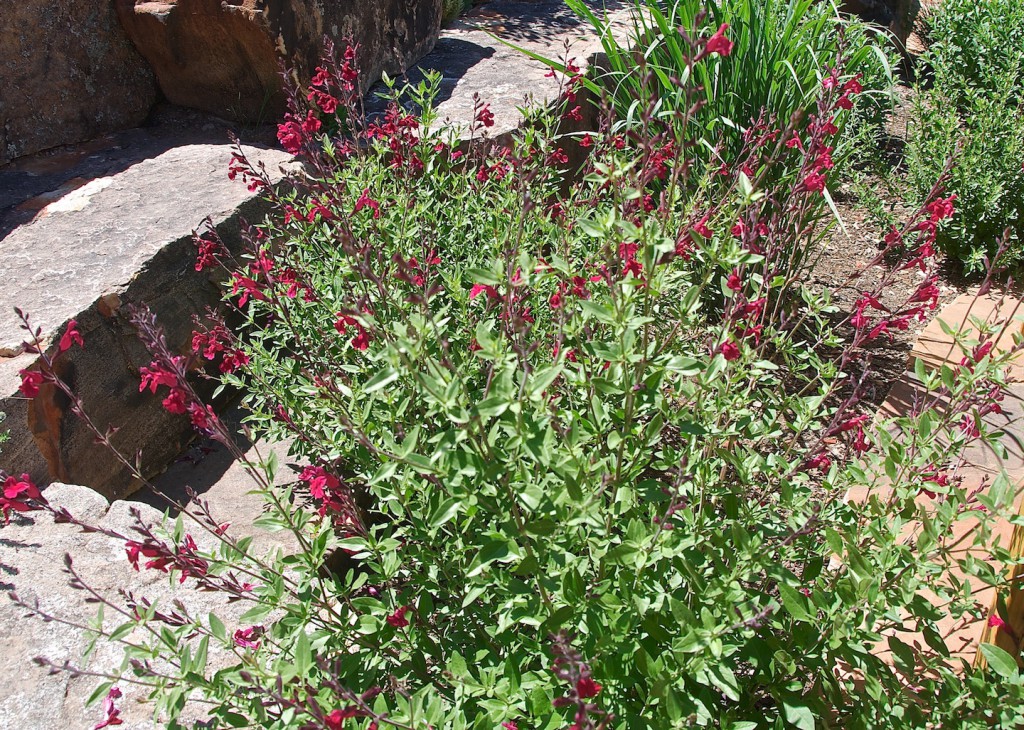
Salvia greggii ‘Furman’s Red’ (Photo by Janice Tucker)
This month’s featured plants are two perennial Salvia cultivars: Furman’s red autumn sage (Salvia greggii ‘Furman’s Red’) and the Vermilion Bluffs Mexican sage (Salvia darcyi ‘Pscarl’ VERMILION BLUFFS). Since both these Salvia cultivars are thriving in the Botanical Garden at Museum Hill, it appears they do quite well in Santa Fe’s USDA Zone 6b. These two beautiful, red-flowering Salvia cultivars will heat up a Santa Fe garden with color, fragrance and active pollinators.
The Salvia greggii ‘Furman’s Red’ is named for W. A. Furman, a well-known Texas plantsman. Although commonly called Furman’s red autumn sage, it blooms from summer through autumn.
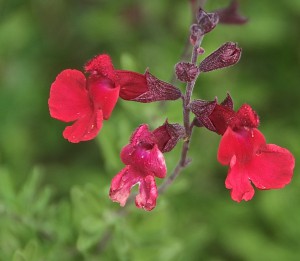
Salvia greggii ‘Furman’s Red’ flower (Photo by Janice Tucker)
Native to Texas and Mexico this perennial cultivar was developed to handle the cold and higher altitudes better than the species plant, S. greggii. Hardy in USDA Zones 6 to 9, it is both drought tolerant and able to withstand temperature swings of hot days and cold nights. The racemes of brilliant red flowers augment the home garden with a dramatic splash of color. The ‘Furman’s Red’ is a compact subshrub that grows to a height of 3 feet and a spread of about 2 feet. Give it a home in a sunny location with well-drained soil. It requires very little supplemental water once it has been established.
In 1998 the Salvia darcyi was discovered growing at 9,000 feet in the eastern Sierra Madre Occidental (also known as Oriental) mountain range of Mexico. It is named in honor of British botanist William D’Arcy. The cultivar, Salvia darcyi ‘Pscarl’ VERMILION BLUFFS, commonly called Vermilion Bluffs Mexican sage, is a registered plant name. Panayoti Kelaidis, who is the senior curator of the Denver Botanic Garden teamed up with the Colorado State University’s Plant Select program to develop this cultivar so that it would withstand the cold winters of the Rocky Mountain region. Hardy in USDA Zones 5 to 9 the Vermilion Bluffs Mexican sage will grow to a height of 3 to 4 feet in full sun in well-drained soil and requires moderate to low supplemental water. It spreads by underground runners. These runners become thickly matted and act as an effective weed barrier. The bright red flowers grow in loose panicles that attractively contrast with triangular, soft, green leaves.
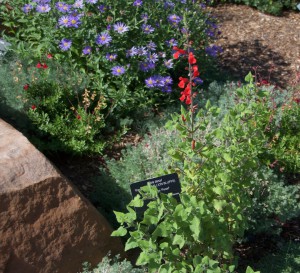
Salvia darcyi ‘Pscarl’ VERMILION BLUFFS (Photo by Janice Tucker)
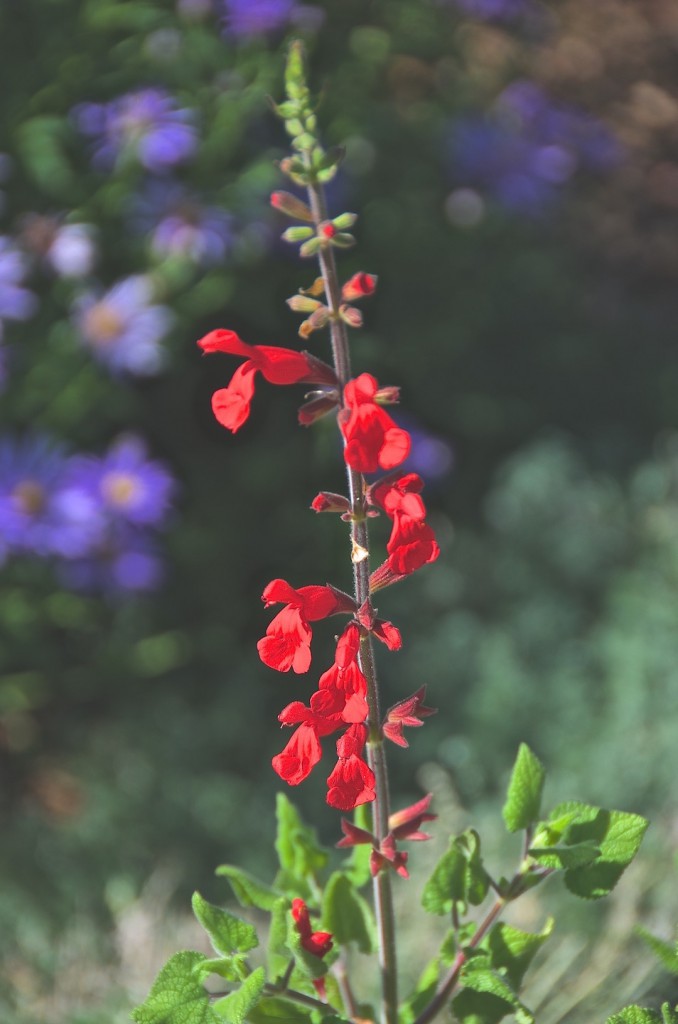
Salvia darcyi ‘Pscarl’ VERMILION BLUFFS flower spike (Photo by Janice Tucker)
Maintenance for both of these perennial cultivars usually consists of deadheading spent flower spikes to encourage additional blooms later in the season. They may die back in the winter but the roots will send up new growth as the ground warms up in spring. Winter mulching is a good practice even though both are considered cold hardy. Just consider mulch like chicken soup for plants…..it can’t hurt.
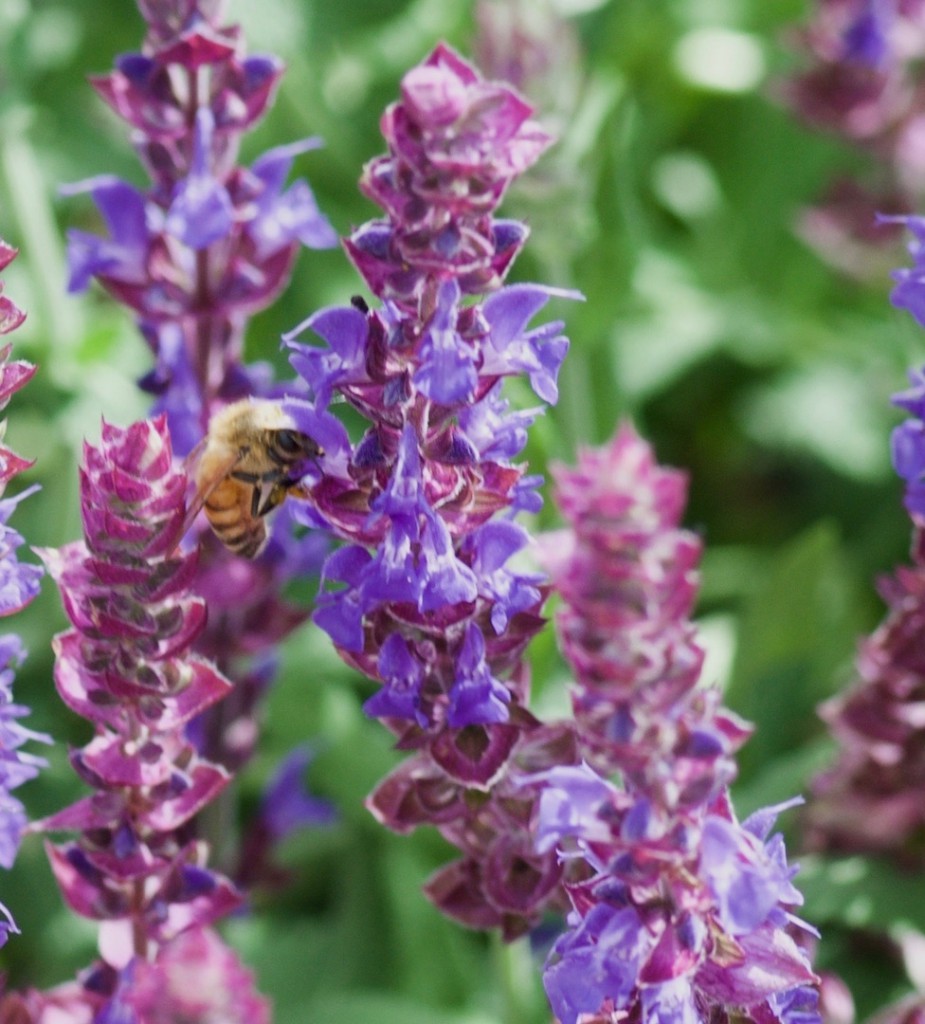
Bee on blue salvia (Photo by Janice Tucker).
Salvia species have panicles or spikes with a claw-like shape. The top petal is “hooded” – like a little canopy perching just above it – and slightly longer than the lower lip-shaped petals. The style protrudes outward from the flower’s throat to a bit past the top petal and hovers just above the slightly shorter stamens. This flower construction along with its fragrance that advertises sweet nectar makes it the perfect host for bees, butterflies and birds. The lower petals act as a landing pad to welcome pollinators. As a pollinator’s proboscis or beak searches for the nectar, it pushes a tiny lever in the center of the stamen. This causes the stamen to bend forward to anoint the pollinator’s head or back with pollen. When the pollinator visits its next flower it will brush up against the style thus depositing its package of pollen from the last flower. Now that’s teamwork!
The Salvia species are commonly known by the genus name but are also often referred to as sage, usually with a descriptive adjective attached. Examples are purple sage, autumn sage, Mojave sage, cherry sage, and so forth. However, common names are not loyal to any plant and there are species in other plant families that also hold the common name of “sage”. But Salvia species are the real deal. One of its species is the culinary sage we love to grow in our garden for use in the kitchen. So don’t go seasoning your Thanksgiving turkey with an Artemisia plant that is also commonly known as a sage.
The featured plants, like most species of the Salvia genus, probably do have medicinal uses. After all, the definition of Salvia is, “helping, saving, healing”. But there are so many sages that it is difficult to pinpoint the precise medicinal value of a particular species. The fact that the entire Lamiaceae (mint) family is legendary for its healing properties may have prompted Michael Moore to write in his book, Medicinal Plants of the Mountain West, “One rule of thumb with this varied family: If they are at least moderately smelly, they are useful as a remedy.”
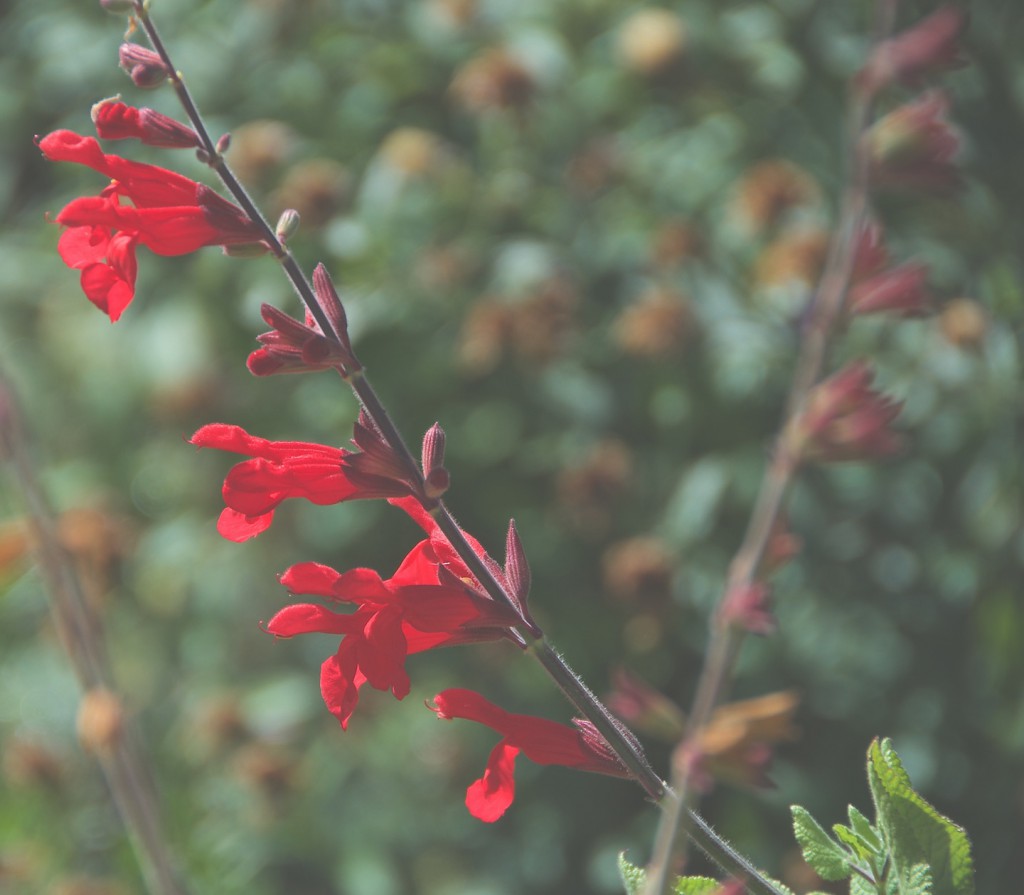
Salvia darcyi ‘Pscarl’ VERMILION BLUFFS (Photo by Janice Tucker)
If you want your Santa Fe garden to radiate in colors of red, purple, blue, hot pink, and/or white flowers, plant Salvia. If fragrance wafting through your Santa Fe garden appeals to you, plant Salvia. If your goal is to attract pollinators to your Santa Fe garden, plant Salvia. If drought tolerant, low maintenance plants are a priority in your Santa Fe garden, plant Salvia.
In other words: Plant Salvia.
Thanks to Helen Woody and Jeanne Gozigian for proofreading this article
Sources consulted:
- Backyard Nature, Putting Pollen Where It’s Needed, http://www.backyardnature.net/fl_polln.htm
- Dave’s Garden, Botanary- Salvia, http://davesgarden.com/guides/botanary/search.php?search_text=salvia
- Flowers by the Sea, Salvia greggii ‘Furman’s Red’, Salvia darcyi, ‘Pscarl’ (VERMILION BLUFFS), and New at FBTS: Vermilion Bluffs Mexican Sage, https://www.fbts.com
- Moore, Michael, Medicinal Plants of the Mountain West
- National Audubon Society, Field Guide to Wildflowers, Western Region
- Phillips, Judith, New Mexico’s Gardener’s Guide
- Salman, David, High Country Gardens Salvia greggii Furman’s Red, http://www.highcountrygardens.com/salvia-greggii-furmans-red


